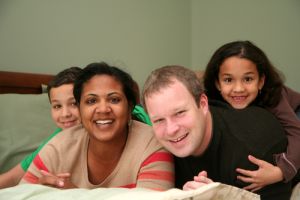
Exploring the history and experiences of mixed heritage persons and inter-racial relationships across the world

Exploring the history and experiences of mixed heritage persons and inter-racial relationships across the world
The countries to be covered on this continent are India, Goa in particular, the Philippines and Indonesia.
The Asian colonial era really began in 1502 when the Portuguese established the first European trading centre at Kollam, Kerala. In 1510 Afonso de Albuquerque conquered Goa and used that city as Portugal's stepping stone to the Far East when in April with a force of seventeen or eighteen ships he conquered Malacca, in present day Malaysia. It became a strategic base for further expansion in the East Indies - South East Asia. In Goa, Albuquerque inaugurated the policy of marrying Portuguese soldiers and sailors with local girls, a policy that appears to have been carried on in Malacca and other Portuguese territories in Asia.
 In Malaysia, a distinct social group known as Kristang was originally descendants of Portuguese and Malaccan but the mix is even pronounced yet because further mixing with Indian and Chinese has occurred. Malaysia is a truly multi-ethnic country, with native Malays making up the majority but with some 30% of Malaysians of Chinese descent and those of Indian descent comprising about 8%.
In Malaysia, a distinct social group known as Kristang was originally descendants of Portuguese and Malaccan but the mix is even pronounced yet because further mixing with Indian and Chinese has occurred. Malaysia is a truly multi-ethnic country, with native Malays making up the majority but with some 30% of Malaysians of Chinese descent and those of Indian descent comprising about 8%.
Between 1602 and 1796 the Dutch East India Company sent almost a million Europeans, not all Dutch, to work in the Asia mainly to the Dutch East Indies which eventually expanded to become Indonesia. Most of these Europeans were male and the Dutch followed the Portuguese example by encouraging the take-up of local wives. In Sri Lanka in which they followed the Portuguese as colonisers, they contributed to the establishment of a distinct community of called the Burghers, descendants of mostly Portuguese, Dutch, German and British colonists and local women. The Burghers make up some about 0.2% of the Sri Lanka's population.
Despite the Dutch, the Portuguese influence was felt all over the Indian sub-continent and the East Indies. Their and the Dutch's inter-racial policies saw a number of distinct mestiço (Dutch: Mesties) , mixed race, populations throughout that part of the world. The Topasses (Tupasses, Topas, Topaz) were a group of who claimed Portuguese ancestry or were natives who had taken up Portuguese culture and language. Topasses were found in such places as Goa, Malacca and Batavia. However, they were particularly regarded as an ethnically mixed Portuguese group that dominated politics on Timor and appear either totally assimilated into the Timor community or now regarded as Indos.
Also originally found all over the East Indies, the mostly Christian and of Indian descendants of freed slaves were the Mardijker who spoke a Portuguese patois. Eventually the term Mardijker came into use for any freed slave and they heavily inter-married with the rest of the East Indian mestiço (Mestizo) communities.
 There are over 500 languages spoken in Indonesia and although predominantly Muslim the country also has large Christian and Hindu populations. In modern Indonesia, the term Indo includes all people of a mixed European and native Indonesian background. They form one of the largest Eurasian communities in the world. The Indo was recognized by Dutch law as Europeans and so after World War II and the declaration of Indonesian independence; some 60,000 of them were 'repatriated' to the Netherlands.
There are over 500 languages spoken in Indonesia and although predominantly Muslim the country also has large Christian and Hindu populations. In modern Indonesia, the term Indo includes all people of a mixed European and native Indonesian background. They form one of the largest Eurasian communities in the world. The Indo was recognized by Dutch law as Europeans and so after World War II and the declaration of Indonesian independence; some 60,000 of them were 'repatriated' to the Netherlands.
Filipino mestizo is a term used in the Philippines to denote Filipinos of mixed native Filipino (Austronesian/Malay/Malayo-Polynesian) and any other non-native ancestry. Furthermore, the offspring of a Filipino and an American is termed an Amerasian and there are some 20,000 to 30,000 who speak mostly English. The majority are to be found in Angeles City, which has the largest proportion of Amerasians in the Philippines. The term African-Filipinos or Afro-Filipino is sometimes used for those of part-African American descent, mostly descending from United States army servicemen.
In Singapore the Eurasian community is acknowledged as a separate ethnic group. English is generally spoken as a first language but some older people do speak a creole known the Kristang language . Singapore recognizes three other languages, namely, Mandarin Chinese, Tamil and Malay as its official languages, with English being the national language. The Eurasian community in Singapore is overwhelmingly Christian, most being Roman but a significant minority do follow Islam.
 Many of the mixed heritage populations have been assimilated into native populations and apart from traditions may be indistinguishable. However some small communities do exists and the largest of the groups, the Indos have dispensed throughout the world though a small minority presence remains in the Far East.
Many of the mixed heritage populations have been assimilated into native populations and apart from traditions may be indistinguishable. However some small communities do exists and the largest of the groups, the Indos have dispensed throughout the world though a small minority presence remains in the Far East.
What is notable about the East Indies is that unlike their counterparts in the Americas, especially in South America, the mixed heritage population have very little in the way of economic and political power which at one stage they did have and this is mainly due to the Japanese invasions during the Second World War when they were normally imprisoned with the Europeans.